
10 Best Readability Tools to Improve Content
Want to make your writing clearer and more engaging? These 10 readability tools can help:
- Hemingway Editor - Highlights complex sentences and suggests simplifications
- Grammarly - Checks grammar, spelling, and clarity
- Readable - Analyzes entire websites for readability
- ProWritingAid - Provides 20+ writing reports and style suggestions
- Yoast SEO - Scores readability and optimizes for SEO (WordPress)
- WebFX Readability Test - Free tool using multiple readability formulas
- Copywritely - Focuses on SEO optimization and readability
- AISEO - AI-powered tool to improve readability
- TheWriter - Uses Flesch-Kincaid to assess and compare writing
- Longshot AI - AI content generator with readability features
Quick Comparison:
| Tool | Key Feature | Best For | Pricing |
|---|---|---|---|
| Hemingway | Simplifies writing | Bloggers, content creators | Free online, $19.99 desktop |
| Grammarly | Grammar + style checks | General writing | Free - $12/mo |
| ProWritingAid | In-depth analysis | Professional writers | $20/mo or $399 lifetime |
| Yoast SEO | WordPress integration | Website owners | $99/year |
| WebFX | Multiple readability scores | Quick checks | Free |
These tools can help make your content easier to read and understand. Pick one that fits your needs and writing style. Remember - readability matters because readers only skim about 20% of content on a page. Make those words count!
What are readability metrics?
Readability metrics are tools that help you figure out how easy your writing is to understand. They look at things like how long your sentences are and how many big words you use.
Let's break down some common readability formulas:
1. Flesch-Kincaid Reading Ease
This score ranges from 0 to 100. Higher scores mean easier reading. Here's a quick guide:
| Score | Readability |
|---|---|
| 90-100 | Very easy |
| 80-89 | Easy |
| 70-79 | Fairly easy |
| 60-69 | Standard |
| 50-59 | Fairly difficult |
| 30-49 | Difficult |
| 0-29 | Very confusing |
2. Flesch-Kincaid Grade Level
This tells you the U.S. grade level needed to understand your text. For example, a score of 8.0 means an eighth-grader should get it.
3. Gunning Fog Index
This estimates how many years of schooling someone needs to understand your writing on the first read. Lower scores are better for a general audience.
4. SMOG Index
SMOG stands for "Simple Measure of Gobbledygook." It's often used for health info because it's consistent across different texts.
5. Dale-Chall Readability Formula
This one uses a list of 3,000 easy words. The more words you use that aren't on this list, the harder your text is to read.
For instance, a news article targeting a general audience might aim to use primarily words from the 3,000-word list, ensuring broader comprehension. Academic papers or specialized technical documents, by contrast, may naturally include more complex terminology
Why do these scores matter? Well, it depends on what you're writing and who you're writing for. If you're creating content for a broad audience, aim for a Flesch-Kincaid Grade Level of about 8. This means most adults can easily understand it.
But remember, these scores are just a starting point. They don't catch everything. For example, they can't tell if your writing makes sense or if it's interesting.
Here's a real-world example: In March 2023, researchers used the SMOG Index to check how easy it was to understand info about depression treatments. They found it worked best for this kind of health writing.
"The SMOG Index showed the greatest consistency across comparisons when assessing written health information on depression and its treatment", the study reported.
So, which metric should you use? It depends on your goals:
- For school texts: Try the Dale-Chall test
- For health info: Go with the SMOG Index
- For general web content: Flesch-Kincaid Grade Level is a good bet
1. Hemingway Editor

The Hemingway Editor is a tool that helps writers create clear, bold text. It focuses on improving readability and style, rather than just fixing grammar and spelling.
Here's what the Hemingway Editor does:
- Highlights complex sentences in yellow
- Marks passive voice in green
- Points out adverbs in blue
- Suggests simpler words for complex ones in purple
- Flags very hard-to-read sentences in red
The tool aims for a Grade 5 or 6 reading level, which most readers prefer. It gives your writing a readability score based on the Flesch-Kincaid metric.
Hemingway offers two modes:
- Write mode: For distraction-free writing
- Edit mode: To see highlighted suggestions
The free online version lets you paste text and get instant feedback. For more features, there's a desktop app for $19.99. This paid version allows you to:
- Work offline
- Import and export files
- Use WordPress integration
Many writers find Hemingway useful alongside other tools. For example, you might use Grammarly for grammar checks, then run your text through Hemingway to improve clarity.
| Feature | Free Online Version | Paid Desktop Version |
|---|---|---|
| Price | $0 | $19.99 (one-time) |
| Readability score | Yes | Yes |
| Color-coded highlights | Yes | Yes |
| Offline use | No | Yes |
| File import/export | No | Yes |
| WordPress integration | No | Yes |
Remember, Hemingway's suggestions are just that - suggestions. Not every highlighted word or phrase needs changing. The goal is to make your writing clearer, not to strip away your style.
"As Stephen King said, 'the road to hell is paved with adverbs'." - The Writer's Cookbook
This quote sums up Hemingway's approach to adverbs. The tool helps you spot and reduce them, pushing you to use stronger verbs instead.
To get the most out of Hemingway:
- Write your first draft without looking at the highlights
- Use edit mode to review and revise
- Read your work out loud after making changes
- Don't feel pressured to act on every suggestion
2. Grammarly

Grammarly is a popular writing assistant that helps improve content readability through various features. It offers real-time feedback on grammar, spelling, and clarity while you write.
Here's how Grammarly enhances readability:
- Readability Score: Grammarly provides a score based on the Flesch reading-ease test. This score ranges from 0 to 100, with higher scores indicating easier-to-read text.
- Sentence Structure: The tool flags hard-to-read sentences and suggests breaking them into shorter, more digestible ones.
-
Conciseness: Grammarly identifies wordiness and offers simpler alternatives. For example:
Wordy Concise "There is flexibility in our plans, so please tell us when you are free." "Our plans are flexible, so please tell us when you are free." "This policy may cause confusion for our clients." "This policy may confuse our clients." - Clarity Enhancements: The tool suggests ways to make your writing clearer and more direct.
- Vocabulary Improvement: Grammarly recommends more precise words to enhance your writing.
Grammarly works across many platforms, including 500,000+ websites and apps. This wide coverage allows users to improve their writing in various contexts, from emails to assignments.
To get the most out of Grammarly:
- Set writing goals for each piece. Grammarly allows you to specify the domain, intent, audience, and formality of your writing.
- Use the real-time feedback to learn and improve as you write.
- Review the suggestions carefully. Not every highlight needs changing - use your judgment.
Grammarly offers both free and paid versions:
| Feature | Free Version | Premium Version |
|---|---|---|
| Basic grammar and spelling checks | Yes | Yes |
| Clarity and conciseness suggestions | Limited | Full |
| Tone adjustments | Yes | Yes |
| Plagiarism checker | No | Yes |
| AI prompts | 100/month | Unlimited |
| Price | $0 | $60/quarter or $144/year |
"If the readability of your text is high, people will be able to understand your sentences easily." - Grammarly
3. Readable

Readable is a powerful tool designed to help writers, marketers, and content creators improve the clarity and effectiveness of their content. It offers a range of features to analyze and enhance text readability.
Key features of Readable include:
- Text Analysis: Readable provides scores based on multiple readability formulas, including Flesch-Kincaid, Gunning Fog, SMOG Index, and Coleman Liau Index.
- Website Scoring: Users can analyze entire websites for readability, helping to improve overall site content.
- Reach Metrics: The tool offers a percentage indicating how much of the audience can understand the content, based on readability and literacy studies.
- Tone and Sentiment Analysis: This feature helps users adjust their content for better audience connection.
- Clear Highlighting System: Readable uses a color-coded system to help users spot areas for improvement quickly.
- Synonym Suggestions: The tool offers simpler alternatives for complex words, helping to make content more accessible.
Readable's pricing structure is straightforward:
| Plan | Price | Features |
|---|---|---|
| ContentPro | $4/month (billed annually) | 1 user, unlimited text, URLs, emails, files, and readability reports |
| CommercePro | $24/month (billed annually) | 3 users, 1 website, website scoring, unlimited alerts, Dropbox and Slack integration |
| AgencyPro | $69/month (billed annually) | 5 users, 3 websites, API access, branded reports |
Readable supports multiple languages, including English, Chinese, German, Hindi, Japanese, Spanish, French, Russian, Italian, Dutch, Portuguese, Polish, Turkish, Swedish, and Arabic. This makes it a versatile tool for content creators working in various languages.
The tool also offers additional features like keyword density detection, adverb count, cliché count, and buzzword count to help users create more original and engaging content.
Readable's effectiveness is recognized by major companies. AON, Uber, and Salesforce are among its prominent clients, indicating its usefulness for businesses of various sizes and industries.
While user satisfaction ratings are not available, experts have given Readable a score of 7.3 out of 10, suggesting it's a solid choice for those looking to improve their content's readability.
4. ProWritingAid

ProWritingAid is a writing tool that checks grammar, spelling, and style while offering features to boost readability. It provides 23 detailed reports to help writers improve various aspects of their work.
The tool's Readability Report uses the Flesch Readability Score to grade content on reading ease. It highlights difficult paragraphs and suggests improvements. For example, it might recommend using "over" instead of "more than" to enhance clarity.
ProWritingAid's key features include:
- Real-time error detection
- Style inconsistency checks
- Sentence length analysis
- Passive voice identification
- Word choice suggestions
The tool allows users to set specific goals for their writing, such as avoiding complex sentences or passive voice. This helps the algorithm provide more relevant suggestions.
ProWritingAid's pricing structure is as follows:
| Plan | Price | Features |
|---|---|---|
| Free | $0 | Check up to 500 words at a time |
| Premium | $120/year or $399/lifetime | Unlimited checks, 5 AI Sparks per day |
| Premium Pro | $144/year or $699/lifetime | 50 AI Sparks per day, more AI functionality |
While ProWritingAid offers many features, it's worth noting that it received a score of 48.7/100 on the A*Help score, indicating it may not be the best free grammar checker available.
"ProWritingAid actually proves to be a writing tutor, because it not only tells you what's wrong with your writing but also exactly how to improve it!" - Kripesh Adwani, Author
ProWritingAid integrates with Google Docs and Microsoft Office, allowing users to edit errors while writing. It's available as a web-based tool, browser extension, and plugin for popular word processing programs.
To get the most out of ProWritingAid:
- Use the Sentence Length Check report to vary sentence lengths and keep readers engaged.
- Customize settings based on your document type (e.g., academic papers, web content) for more relevant suggestions.
- Focus on the highlighted difficult paragraphs in the Readability Report to make targeted improvements.
While ProWritingAid offers detailed analysis, it lacks a mobile app and some users have noted issues with grammar-checking quality. Consider your specific needs when choosing between ProWritingAid and other tools like Grammarly or Quillbot.
5. Yoast SEO

Yoast SEO, a popular WordPress plugin, offers a robust readability analysis tool to help writers create clear, engaging content. This feature uses a traffic light system (green, orange, red) to rate various aspects of your text.
The readability analysis focuses on six key areas:
- Transition words
- Sentence beginnings
- Paragraph length
- Sentence length
- Passive voice
- Flesch Reading Ease score
Here's a breakdown of Yoast's readability checks:
| Check | Green Light Criteria |
|---|---|
| Transition words | Used in 30%+ of sentences |
| Consecutive sentences | No more than 3 start with same word |
| Paragraph length | Max 150 words |
| Sentence length | 75%+ under 20 words |
| Passive voice | Used in less than 10% of sentences |
| Flesch Reading Ease | Score of 60-70 or higher |
To use Yoast SEO's readability tool:
- Install the Yoast SEO plugin on your WordPress site
- Write your content in the WordPress editor
- Check the readability analysis in real-time
- Address issues highlighted by orange or red bullets
- Aim for an overall green score, but remember not all checks need to be green
Yoast SEO's readability analysis works in multiple languages, including English, German, French, Spanish, and Russian. This makes it useful for multilingual websites.
"You're not dumbing down, you're opening up." - Sarah Richards, Content Design Hero
While Yoast SEO's readability tool is helpful, it's important to note that readability doesn't directly impact SEO rankings. Focus on creating content that addresses search intent and provides value to readers.
To get the most out of Yoast SEO's readability analysis:
- Use the highlighter tool to pinpoint issues within your content
- Balance readability with your writing style and target audience
- Remember that some orange bullets are acceptable
- Use the tool as a guide, not a strict rulebook
6. WebFX Readability Test
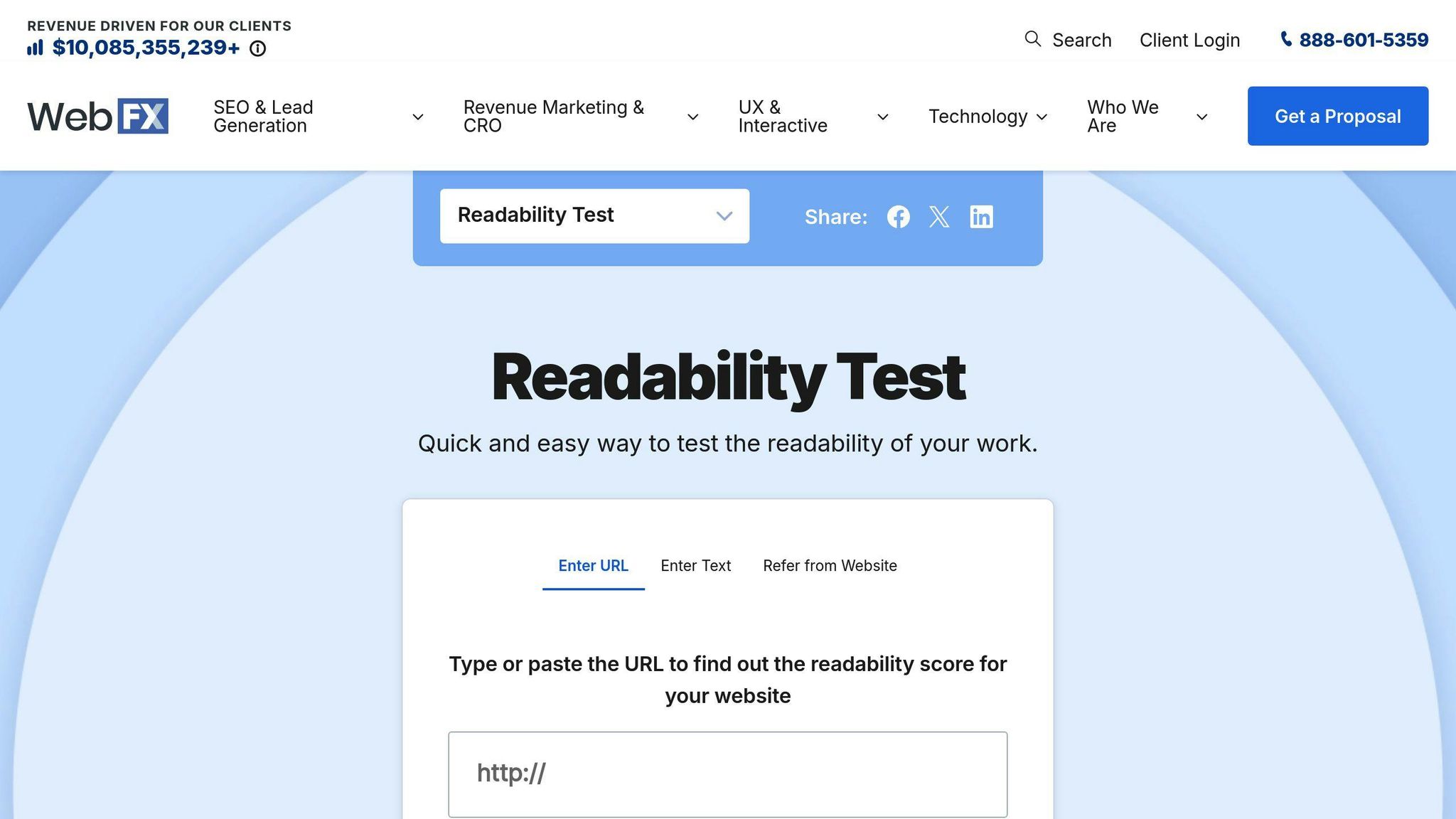
The WebFX Readability Test is a handy online tool that helps writers gauge how easy their content is to read and understand. It uses several standard readability indicators to give you a clear picture of your writing's accessibility.
Here's what the WebFX Readability Test offers:
| Feature | Description |
|---|---|
| Multiple Readability Scores | Provides scores for Flesch Kincaid Reading Ease, Gunning Fog Score, Coleman Liau Index, and more |
| ARI Score | Calculates the Automated Readability Index to estimate U.S. grade level needed to comprehend the text |
| Text Statistics | Shows number of complex words and average words per sentence |
| Flexible Input Options | Allows testing via URL, copy-paste, or embed code |
| Audience Suitability | Summarizes appropriate age range for the content |
To use the WebFX Readability Test:
- Visit the WebFX Readability Test website
- Enter your text or website URL
- Click "Calculate Readability"
- Review your scores and text statistics
- Use the insights to refine your writing
The tool is particularly useful for content creators aiming to reach a wide audience. Remember, the average American adult reads at a 7th to 9th grade level, so keeping your content accessible is key.
"The WebFX Readability Test helps ensure the writing resonates with the intended audience", notes the WebFX team.
For best results:
- Aim for a Gunning Fog Index score of 7 or 8
- Keep sentences short and simple
- Use fewer complex words
- Break up long paragraphs
sbb-itb-1831901
7. Copywritely
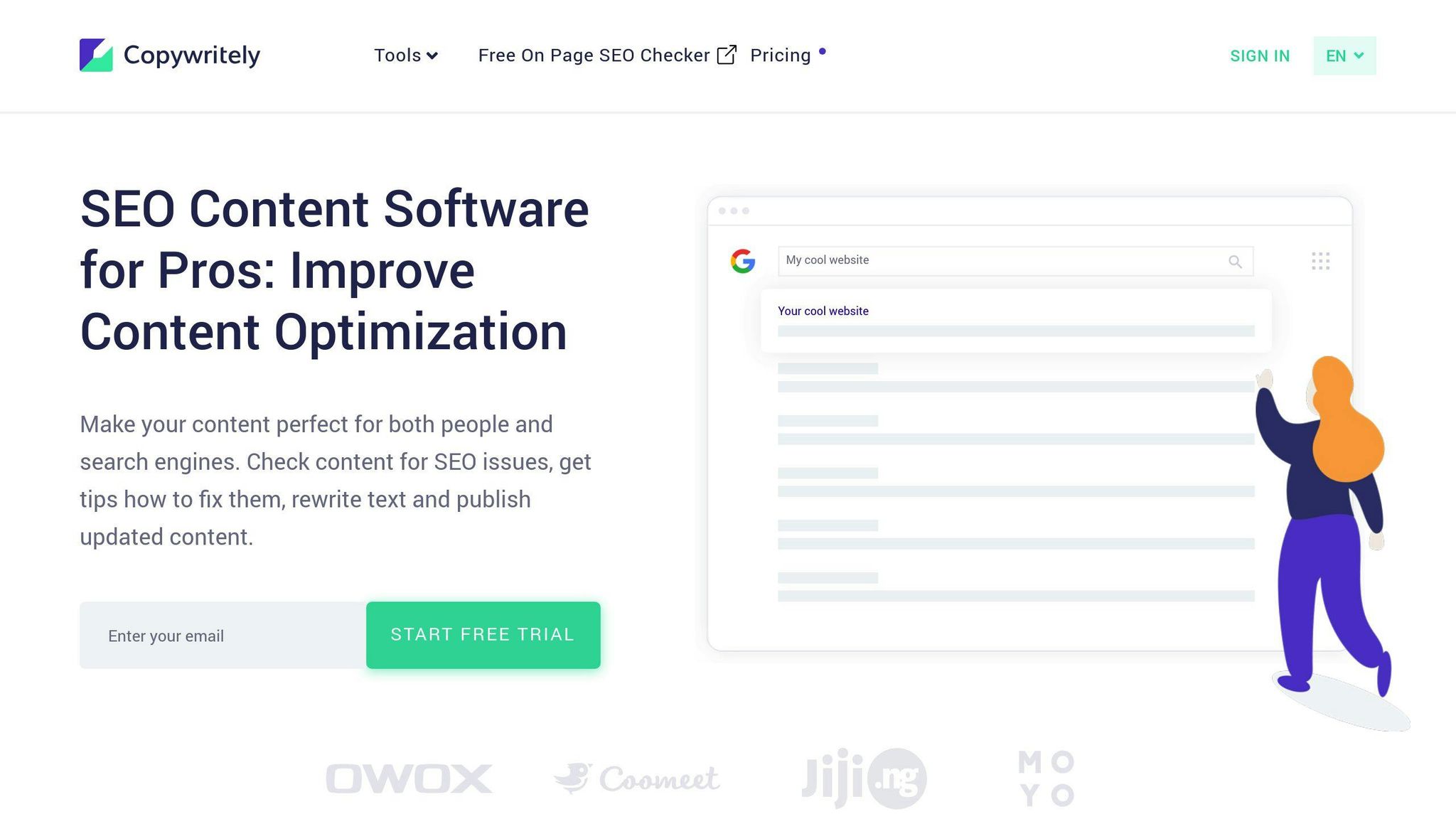
Copywritely is an SEO-focused content tool that helps writers improve their content for both search engines and readers. It offers a range of features to enhance readability and optimize text for better search rankings.
Here's a breakdown of Copywritely's main readability features:
| Feature | Description |
|---|---|
| Readability Indexes | Uses Flesch and Gunning Fog scales to measure text complexity |
| Grammar Checker | Identifies and suggests corrections for grammatical errors |
| Keyword Density Checker | Analyzes keyword frequency to prevent over-optimization |
| Uniqueness Checker | Detects potential plagiarism and similar phrases |
| Content Analysis | Highlights areas for improvement in the text |
Copywritely's readability checker presents scores as progress bars, making it easy to see how your content measures up. The tool highlights specific areas that need work and offers suggestions to boost readability.
To get the most out of Copywritely:
- Replace long words with shorter alternatives when highlighted
- Remove redundant phrases flagged by the tool
- Mix up sentence lengths for better flow
- Use the keyword density checker to avoid over-stuffing
While Copywritely is helpful, it has some limitations. It doesn't catch all instances of passive voice or flag overuse of adverbs, which can impact readability. Users should keep this in mind and do additional manual checks.
Pricing for Copywritely starts at $29 per month for the basic plan, which allows checking up to 50 pages (125,000 words) monthly. This might be steep for freelancers or small businesses, but it could be worth it for those producing a high volume of content.
"Copywritely allows me to create my content in a perfect way for all people and for all the mechanisms that organize and distribute all the information created", says Pankaj Singh Shah, Manager of Marketing at Quark.
For those looking to try before they buy, Copywritely offers 10 free text proofs upon registration. This gives users a chance to test the tool's capabilities and see if it fits their needs before committing to a paid plan.
8. AISEO
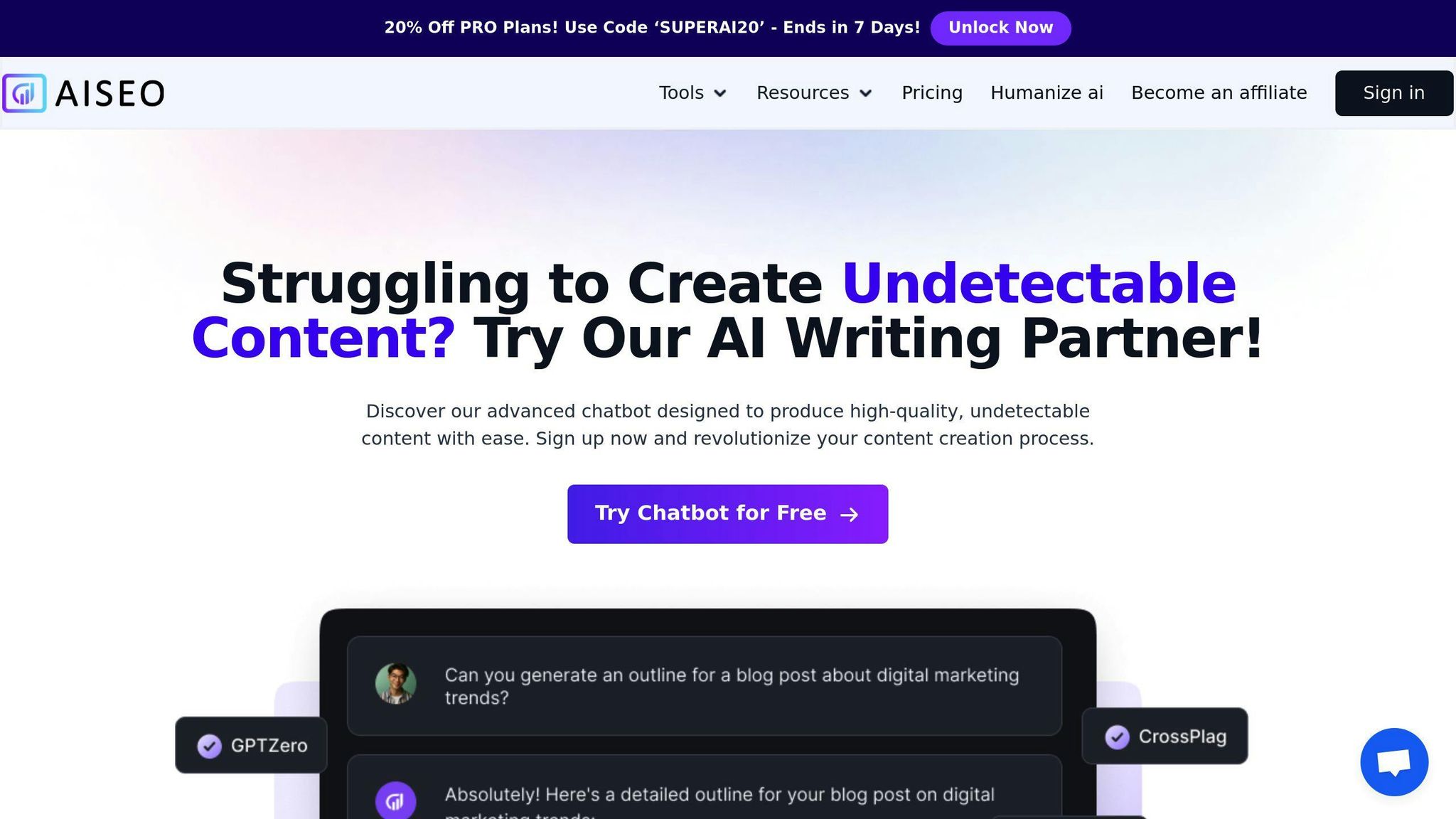
AISEO is an AI-powered writing assistant that helps improve content readability and SEO optimization. It offers a suite of tools designed to enhance the writing process, including a readability improver that works with the Hemingway Editor.
Here's a breakdown of AISEO's key features for improving content readability:
| Feature | Description |
|---|---|
| Readability Improver | Scans content and highlights sentences that need improvement |
| Hemingway Editor Integration | Identifies complex sentences and suggests automatic improvements |
| Paraphrasing Tool | Helps rephrase text for better clarity |
| Long-form Assistant | Generates high-quality content in 26 languages |
To use AISEO's readability tools effectively:
- Paste your article into the Readability Improver
- Review highlighted sentences that need improvement
- Use inline tools to correct individual sentences
- Click the "Improve" button for automatic readability enhancements
AISEO's Readability Improver can process up to 3000 characters of content at a time. This tool is particularly useful for content creators looking to make their writing more accessible and engaging.
The pricing for AISEO starts at $19 per month for the "Grow" plan, which includes unlimited SEO documents, paraphrasing, and access to the Hemingway Readability Improver with AI. For those who want to try before committing, AISEO offers a 7-day free trial.
While AISEO can help improve readability scores, it's important to note that the output should be checked for plagiarism, as the generated content is unique but may require further optimization for SEO purposes.
9. TheWriter
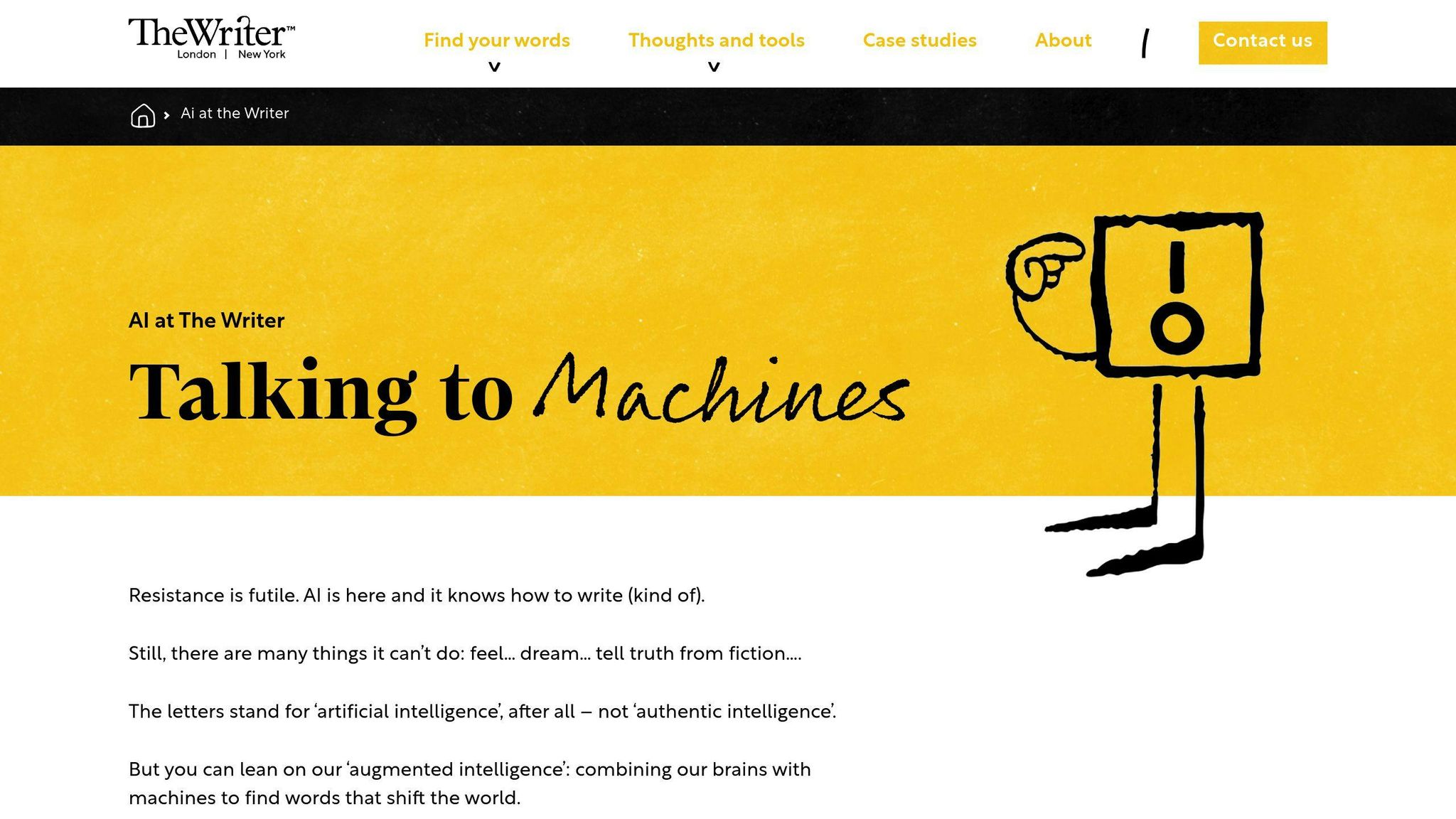
TheWriter is an AI-powered tool that helps improve content readability through its built-in readability checker. This tool uses the Flesch-Kincaid readability test to assess how easy your writing is to read and understand.
Key features of TheWriter's readability tool include:
| Feature | Description |
|---|---|
| Readability Score | Provides a score based on the Flesch reading ease scale |
| Comparison | Compares your writing to famous books and authors |
| Privacy | Does not store, share, or record submitted text |
| Word and Sentence Analysis | Measures length of words and sentences for clarity |
To use TheWriter effectively:
- Paste your text into the readability checker
- Review the readability score and comparisons
- Focus on shortening long sentences
- Replace passive voice with active voice
- Simplify complex words and remove jargon
TheWriter recommends aiming for a readability score between 60 and 70 out of 100 for standard written documents. This range helps make your content more accessible to a wider audience, including those with neurodiversity or non-native English speakers.
Pricing for TheWriter starts at $24 per month for the Basic plan, with Standard and Power plans available at $49 per month and $312 per year, respectively.
While TheWriter offers useful readability features, it's worth noting that it doesn't support automatic citation formatting in academic styles like APA or MLA. This limitation may affect its usefulness for students and professionals who need to adhere to specific formatting guidelines.
"Readers prefer simpler writing, regardless of their education level", as supported by studies from Nielsen Norman Group.
10. Longshot AI
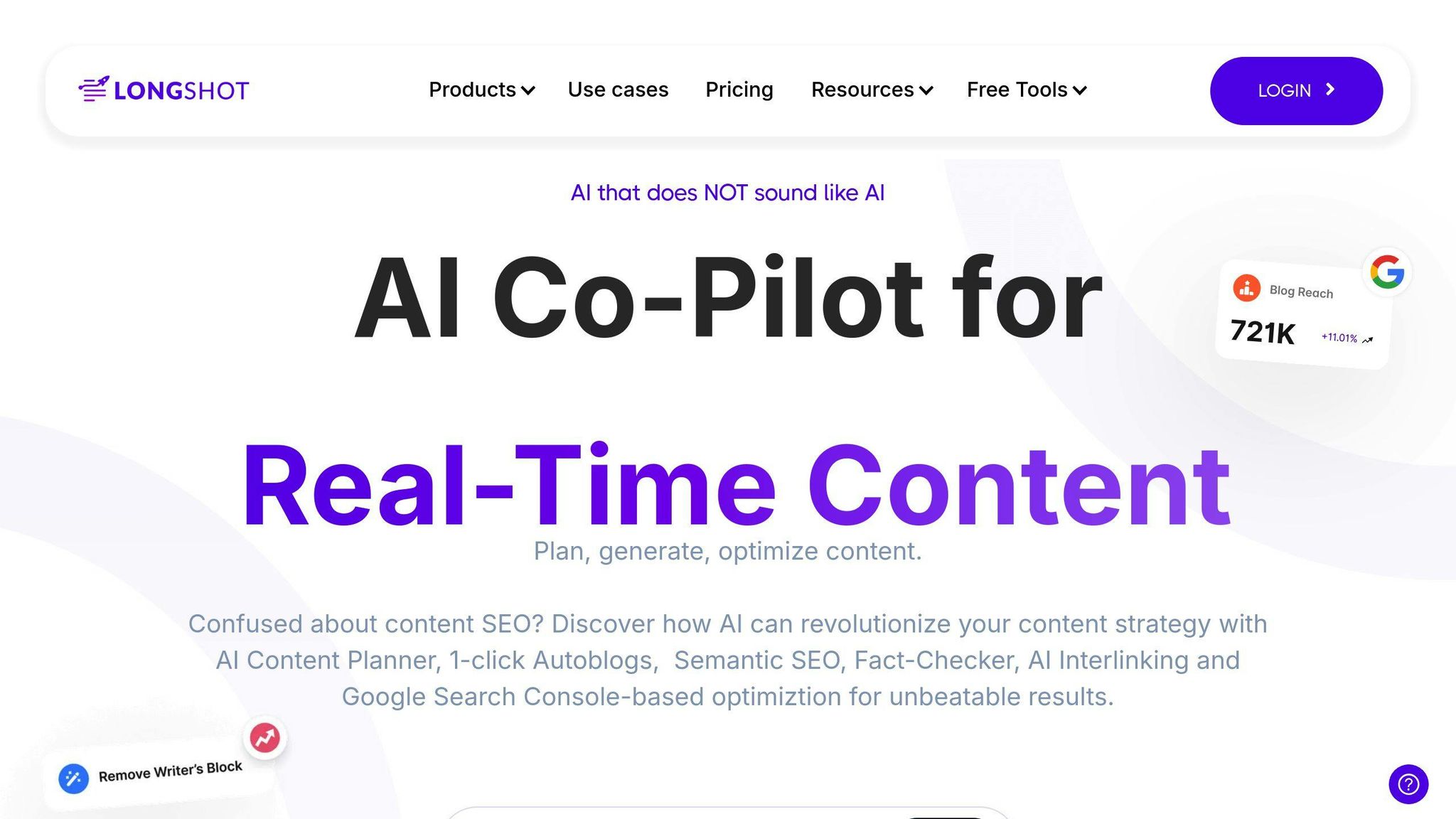
Longshot AI is an AI-powered writing assistant that helps users create and improve content. It offers a range of features to enhance readability and optimize content for search engines.
Key features of Longshot AI include:
| Feature | Description |
|---|---|
| FactGPT | Verifies factual accuracy of content |
| AI Content Planner | Helps structure and organize content strategies |
| SEO Checker | Optimizes content for search engines |
| AI Interlinking | Enhances internal linking |
| Plagiarism Detection | Scans against billions of web pages |
Longshot AI uses GPT-3 technology to generate content, from short-form pieces to full articles. Its AI workflows guide users through a three-step process:
- Headline creation
- Outline development
- Content editing
The platform's FactGPT module is a standout feature, ensuring content accuracy and saving time on research and fact-checking. This can be particularly helpful for academic writing where factual precision is key.
Longshot AI offers multiple pricing tiers:
| Plan | Price | Features |
|---|---|---|
| Free Trial | $0 | 100 credits, 2 weeks |
| Pro | $19/month | ~100,000 words/month, 1 user |
| Team | $49/month | ~500,000 words/month, 5 users |
| Agency | $299/month | Millions of words, unlimited users |
For students and academics, Longshot AI's ability to generate citations and references can be a time-saver. However, it's worth noting that the platform doesn't offer automatic formatting in specific citation styles like APA or MLA.
"I love that LongShot AI will practically write the blog article for you with the keywords that you set. Not only will it give you keyword ideas to 'unstuck' your writing and flow, but it will also actually write better copy than you could about them with..." - Joseph K., Verified User in Marketing and Advertising.
While Longshot AI offers many helpful features, users should be aware that some reviewers have noted minimal feedback provided by the tool. Those looking for more in-depth writing analysis might need to consider additional tools or services.
How do these readability tools compare?
To help you choose the right tool for your needs, let's compare the top 10 readability tools based on their features, pricing, and ease of use:
| Tool | Key Features | Pricing | Ease of Use |
|---|---|---|---|
| Hemingway Editor | Highlights complex sentences, adverbs, and passive voice | Free online, $19.99 for desktop app | Very easy |
| Grammarly | Grammar, spelling, tone checks, plagiarism detection | Free basic plan, Premium from $12/month | Easy |
| Readable | Website readability tool, keyword density analysis | From $4/month (individual) | User-friendly |
| ProWritingAid | 20+ writing reports, style suggestions | From $20/month or $399 lifetime | Moderate |
| Yoast SEO | Readability scoring, SEO optimization | $99/year for premium | Easy (WordPress integration) |
| WebFX Readability Test | Multiple readability standards, simple interface | Free | Very easy |
| Copywritely | SEO optimization, readability scoring | From $18/month (individual) | Moderate |
| AISEO | AI-driven readability improvements | Paid plans available | Easy |
| TheWriter | Flesch reading ease scale grading | Free | Very easy |
| Longshot AI | AI-powered content generation, readability improvement | From $19/month | Easy |
Each tool has its strengths:
- Hemingway Editor focuses on simplifying writing, making it ideal for bloggers and content creators aiming for clarity.
- Grammarly offers a wide range of features, from basic grammar checks to advanced tone analysis, suitable for various writing tasks.
- Readable stands out with its website-specific tools, helpful for businesses looking to improve their online content.
- ProWritingAid provides in-depth analysis, making it a good choice for professional writers and authors.
- Yoast SEO combines readability checks with SEO optimization, perfect for WordPress users focused on improving their website's performance.
When choosing a tool, consider your specific needs. For example, if you're a student or academic, ProWritingAid's detailed reports might be more helpful. For quick checks, Hemingway or WebFX could be sufficient.
How to pick the right readability tool
Choosing the best readability tool for your needs depends on several factors. Here's how to make an informed decision:
-
Know your audience: Different tools suit different content types and industries. For example:
- For educational materials, the Dale-Chall test is highly effective. It's particularly good at selecting texts for students across various ability levels.
- In healthcare, the SMOG Index is recommended. It's shown to be consistent across different readability assessments for health information.
-
Consider your content type: Some tools are better suited for specific content:
Content Type Recommended Tool Why Blog posts Hemingway Editor Focuses on simplifying writing, ideal for clarity Academic papers ProWritingAid Provides in-depth analysis suitable for complex writing Website content Readable Offers website-specific tools for improving online content General writing Grammarly Wide range of features for various writing tasks -
Check for specific features: Look for tools that offer the metrics you need:
- Flesch-Kincaid Grade Level and Flesch Reading Ease are standard formulas used by many marketing teams.
- For SEO-focused content, tools like Yoast SEO combine readability checks with search engine optimization.
- Consider ease of use: Some tools are more user-friendly than others. For example, WebFX Readability Test offers a simple interface for quick checks, while ProWritingAid provides more detailed reports but may have a steeper learning curve.
-
Budget constraints: Prices vary widely:
- Free options: Hemingway Editor (online version), WebFX Readability Test
- Paid options: Grammarly (from $12/month), ProWritingAid (from $20/month or $399 lifetime)
- Integration needs: If you use specific platforms, look for compatible tools. For instance, Yoast SEO integrates well with WordPress sites.
- Test before committing: Many tools offer free trials or basic versions. Use these to test which tool works best for your writing style and needs.
Remember, while readability tools are helpful, they shouldn't replace human judgment. As the Nielsen Norman Group suggests, aim for an 8th-grade reading level for a broad audience, but adjust based on your specific readers.
"The average attention span of internet users dropped from 12 seconds in 2000 to 8 seconds in 2008, highlighting the importance of readability in capturing attention."
This statistic underscores why choosing the right readability tool is crucial for engaging your audience effectively.
How to use readability tools in your writing
Using readability tools effectively can greatly improve your content's clarity and impact. Here's how to make the most of these tools in your writing process:
- Start with a draft: Write your content without worrying about readability first. Many professional writers follow the 'write first, edit later' principle, understanding that trying to perfect each sentence during the initial draft can interrupt the creative flow and stifle original thinking. This allows your ideas to flow freely.
- Run your content through a tool: After drafting, use a readability tool like Hemingway Editor or Grammarly to analyze your text.
-
Focus on key metrics: Pay attention to:
Metric Target Why It Matters Sentence length 20 words or less Improves comprehension Paragraph length 3-4 sentences Enhances scannability Reading grade level 7th-8th grade Widens audience reach Passive voice Less than 10% Makes writing more direct -
Address highlighted issues: Most tools highlight areas for improvement. Work through these systematically:
- Shorten long sentences by breaking them up
- Replace complex words with simpler alternatives
- Convert passive voice to active where possible
- Use the tool's suggestions wisely: Don't accept every suggestion blindly. Consider each in the context of your content and audience.
- Iterate and recheck: After making changes, run your content through the tool again. Repeat until you're satisfied with the results.
- Balance readability with your voice: While aiming for clarity, maintain your unique writing style.
- Consider your audience: Adjust your target readability based on who you're writing for. Technical audiences may require more complex language.
- Use visual aids: Break up text with bullet points, subheadings, and tables to improve overall readability.
- Read aloud: After using the tool, read your content aloud. This helps catch awkward phrasing that tools might miss.
Remember, readability tools are guides, not rules. Use them to enhance your writing, not to replace your judgment.
"Users only read about 20 percent of the text on an average page." - The Nielsen Norman Group
This statistic highlights why making your content easily scannable and digestible is crucial.
Wrap-up
Readability isn't just a buzzword—it's a game-changer for your content. In today's fast-paced digital world, where users skim more than they read, making your content easy to digest is key.
Let's face it: your brilliant ideas won't matter if no one can understand them. That's where readability tools come in handy. They're like your personal content coaches, helping you transform complex thoughts into clear, engaging prose.
Here's why you should care about readability:
- It boosts engagement: When your content is easy to read, people stick around longer.
- It improves SEO: Search engines favor content that's user-friendly.
- It widens your audience: Simple language reaches more people.
Remember this eye-opening stat from The Nielsen Norman Group:
"Users only read about 20 percent of the text on an average page."
This means every word counts. You need to make those words work hard for you.
Ready to level up your content? Here's a quick action plan:
- Pick a tool from our top 10 list.
- Run your existing content through it.
- Make the suggested tweaks.
- Watch your readability scores improve.
Don't aim for perfection—aim for progress. Even small changes can make a big difference in how your audience connects with your content.
While these tools are incredibly helpful, remember that they're assistants, not replacements for human creativity and nuanced communication. Your unique voice, authentic storytelling, and genuine connection with readers will always matter most.
So, give these readability tools a spin. Your readers (and your analytics) will thank you.
FAQs
What is the most accurate readability checker?
There's no single "most accurate" readability checker, as different tools use various formulas and focus on different aspects of writing. However, some popular and reliable options include:
- Hemingway Editor: Highlights complex sentences and suggests simpler alternatives.
- Readable: Provides grade-level assessments and identifies writing issues.
- Grammarly: Offers real-time feedback on grammar, clarity, and tone.
Here's a quick comparison of these tools:
| Tool | Key Features | Best For |
|---|---|---|
| Hemingway Editor | Simplifies complex writing | Quick edits and style improvements |
| Readable | Grade-level scoring | In-depth readability analysis |
| Grammarly | Grammar and tone suggestions | Overall writing enhancement |
When choosing a readability tool, consider your specific needs. For example, if you're writing technical content, you might prefer tools that use the Automated Readability Index (ARI) or Coleman-Liau Index.
